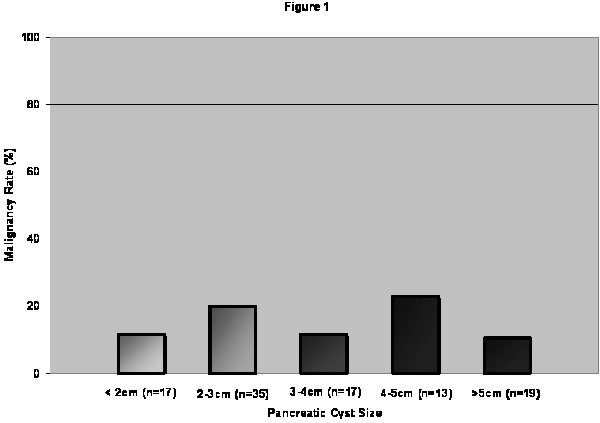Introduction: Proposed criteria for resection of pancreatic cystic lesions have included symptoms, size (>3 cm), and suspicious features by endoscopic ultrasound (EUS). The objective of this study was to evaluate risk factors for malignancy in a large series of patients undergoing resection of suspected pancreatic cystic neoplasms. Methods: Medical records of patients selected for resection of pancreatic cystic lesions at DUMC from 2000 to 2008 were reviewed. Lesions with solid components on cross-sectional imaging were excluded. Malignancy was defined as invasive or in situ carcinoma. Results: After review, 101 patients were confirmed to have undergone resection for suspected cystic neoplasms of the pancreas. Preop EUS was performed in 71 patients. Sixteen patients had malignant lesions (preop size 1.5-5.9 cm). There was no clear association between size and malignancy (Figure 1). Male gender, biliary ductal dilatation (BDD), pancreatic ductal dilatation (PDD), and suspicious cytology (but not age, symptoms, or size) were associated with increased risk of malignancy (Table 1). When factors available for all patients were incorporated into a multivariate model, only BDD and PDD were independent risk factors for malignancy. Only one patient with malignancy had neither BDD nor PDD but did have solid components by EUS. Conclusions: In patients selected for resection, size was not an independent risk factor for malignancy. While size might be appropriate for stratification of asymptomatic patients with simple cysts, size should not be used as a selection criterion for patients who have cysts with solid components or with associated BDD or PDD.
Table 1 - Malignancy Rate
| Gender (Male) | Yes (n=34) 26% | No (n=67) 10% | P value 0.04 |
| Bile Duct Dilatation | Yes (n=8) 62% | No (n=93) 12% | P value 0.002 |
| Pancreatic Duct Dilatation | Yes (n=28) 32% | No (n=66) 8% | P Value 0.004 |
| Suspicious cytology | Yes (n=11) 46% | No (n=60) 8% | P Value 0.014 |

 500 Cummings Center
500 Cummings Center +1 978-927-8330
+1 978-927-8330
 +1 978-524-0461
+1 978-524-0461